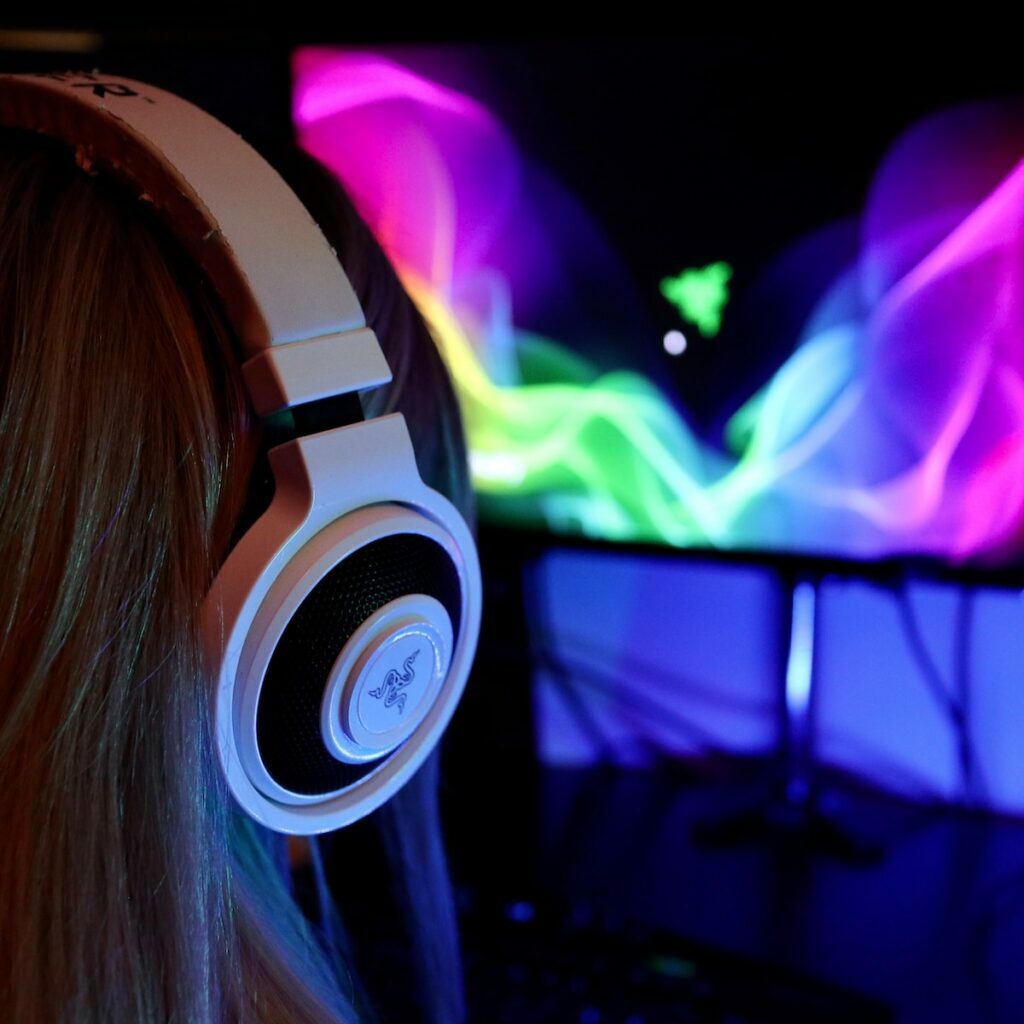
Below are some more detailed aspects to consider when choosing a gaming headset:
Earcup Size
The size of the earcups can have a big impact on the comfort and noise isolation of a headset. Larger earcups can provide more comfort, but smaller earcups may be more portable. There are four main types of earcup sizes for headphones: circumaural/over-ear, on-ear, in-ear, and earbud.
- Circumaural/Over-Ear: Circumaural headphones, also known as over-ear headphones, have earcups that completely encompass the ear. They are typically the most comfortable and offer the best noise isolation, making them a good choice for gaming and other activities where you want to be fully immersed in audio.
- On-Ear: On-ear headphones have smaller earcups that rest on the ear instead of surrounding it. They are typically less comfortable than over-ear headphones, but still provide good sound quality and noise isolation. On-ear headphones can be a good choice for gamers who want a portable option or for those who don’t like the feeling of having their ears fully enclosed.
- In-Ear: In-ear headphones, also known as earbuds, are inserted directly into the ear canal. They are the most portable type of headphones and offer good noise isolation, but can be uncomfortable for some people. In-ear headphones are a good choice for mobile gaming or for those who need to be able to hear their surroundings while gaming.
- Earbuds: Earbuds are a type of in-ear headphone that sit outside of the ear canal. They are typically less expensive and more portable than in-ear headphones, but offer less noise isolation and lower sound quality. Earbuds can be a good choice for casual gaming or for those who don’t want to spend a lot of money on a gaming headset.
Microphone
A good gaming headset should have a clear and adjustable microphone. Consider the type of microphone (boom, in-line, or integrated) and its sensitivity and noise cancelling capabilities.
- Boom Microphone: A boom microphone is a separate component that extends from the headset and can be adjusted to the desired position. Boom microphones are typically the most versatile and offer the best sound quality. They are a good choice for serious gamers who want the best possible audio quality.
- In-Line Microphone: An in-line microphone is built into the cable of the headset and can typically be adjusted to the desired position. In-line microphones are less versatile than boom microphones, but still offer good sound quality. They are a good choice for gamers who want a portable option.
- Integrated Microphone: An integrated microphone is built into the headset itself, typically on one of the earcups. Integrated microphones are the least versatile type of microphone, but are still capable of providing clear audio. They are a good choice for gamers who want a compact and simple headset without the hassle of a separate boom microphone.
Connectivity
Gaming headsets can be connected to your gaming device in several ways, including wired (USB or 3.5mm), or wireless (Bluetooth or Wi-Fi). Consider which type of connectivity is best for your needs.
- Wired Connectivity: Wired gaming headsets are connected to the gaming device using a cable. Wired headsets typically offer the best audio quality and the lowest latency, making them ideal for serious gaming. They are also generally more affordable than wireless and Bluetooth options.
- Wireless Connectivity: Wireless gaming headsets use a wireless connection to connect to the gaming device. They offer the added convenience of not being tethered to the device, allowing for greater mobility. However, wireless connectivity can sometimes result in audio lag or latency, which can be problematic for fast-paced games. Wireless gaming headsets are also more expensive than wired options.
- Bluetooth Connectivity: Bluetooth gaming headsets use Bluetooth technology to connect to the gaming device. Bluetooth connectivity is generally the most convenient and versatile option, as it allows the headset to connect to multiple devices. However, Bluetooth connectivity can also result in audio lag or latency, and the audio quality may not be as good as with wired or wireless options.
Surround Sound
Look for a headset with support for 7.1 or 5.1 surround sound.Surround sound can allow you to hear footsteps or gunfire coming from different directions, giving you a competitive edge in first-person shooters. It can also create a more immersive atmosphere in role-playing games, allowing you to better distinguish between different sounds in the environment and adding to the overall enjoyment of the game.There are two main types of surround sound technology in gaming headsets: virtual surround sound and true surround sound.
- Virtual surround sound uses software processing to create a surround sound experience from a set of stereo headphones. While virtual surround sound can provide a good approximation of surround sound, it is not as accurate as true surround sound.
- True surround sound, on the other hand, uses multiple drivers in each earcup to produce sound from different directions, creating a more accurate and immersive surround sound experience. True surround sound is typically found in high-end gaming headsets and can greatly enhance the gaming experience.
Frequency Response
The frequency response refers to the range of audio frequencies that a headset can produce. A wider frequency response can result in better and more accurate sound.
For gaming headsets, a driver size of 40mm or larger is generally considered good. Larger driver sizes provide more room for the speaker to produce high-quality sound, and they can also produce deeper and more powerful bass.
Noise Isolation
Noise isolation refers to how well a headset blocks out external noise. There are two main types of isolation in headphones and headsets: passive noise isolation and active noise cancellation.
- Passive Noise Isolation: Passive noise isolation refers to the physical design of the headphones or headset that blocks out external noise. This is achieved through the use of materials such as foam padding or seals around the earcups that prevent sound from entering or escaping. Passive noise isolation is most effective at blocking out low-frequency sounds, such as the rumble of an airplane engine
- Active Noise Cancellation (ANC): Active noise cancellation uses microphones and electronics to actively cancel out external noise. The headset’s microphones pick up external noise, and the electronics generate a sound wave that is the exact opposite, effectively cancelling out the noise. Active noise cancellation is most effective at blocking out mid- to high-frequency sounds, such as the hum of a fan or the noise of a crowded room.
When choosing a gaming headset, it’s important to consider your needs and preferences. Factors such as audio quality, comfort, and microphone quality are important for all gamers, while other factors such as surround sound capabilities, connectivity options, and noise isolation may be more relevant to some gamers than others.
Additionally, it’s important to consider your budget, as gaming headsets can range from affordable options to high-end, premium models.











































